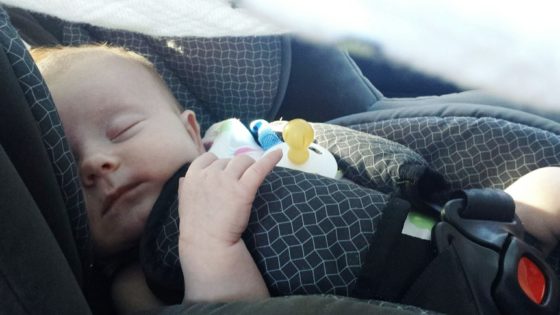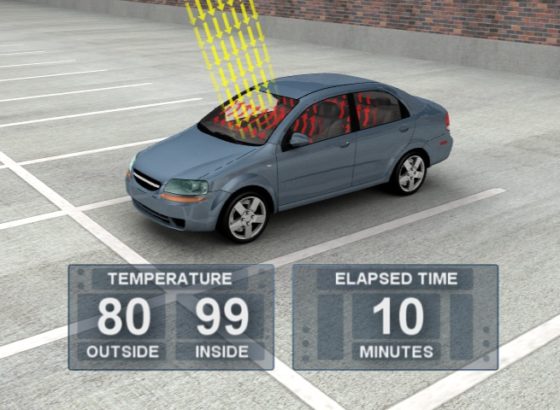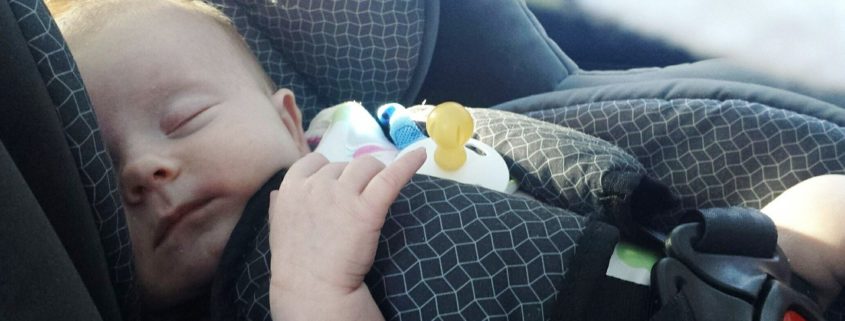Hot-Car Deaths: How to Avoid Deadly Child Heatstroke

While it’s unlikely you’d ever leave your baby in the car alone, particularly a newborn, what if you did? What if you made a snap judgment, a small mistake, and it cost you big?
That’s what happens to more than three dozen families per year in the U.S. Heatstroke can easily be fatal; since 1998, 712 children have died of heatstroke after being left in cars. Twelve children have already died this year, and we’re not even fully into summer yet.
If you want to know how to recognize the signs of heatstroke and prevent it, what laws surround heatstroke, and what new technologies are combating this tragedy, read on.
Contents
How does heatstroke happen?
First off, let’s get into some of the scary stories involving heatstroke and how it occurs. Heatstroke is a big deal. It can happen seemingly in the blink of an eye.
Take for instance a West Virginia great-grandmother who in April left her 19-month-old great-grandson in a vehicle for seven hours. The woman had dropped the boy’s mother off at work, returned home and brought back inside the boy’s 4-year-old sister, but left the baby strapped in his car seat. When she got back into the car hours later to pick up the mother from work, the boy was already dead.
The temperature that day — in April — was 81 degrees. But inside a hot car not parked in the shade, it could have been anywhere from 120 to 140 degrees Fahrenheit.
According to the National Weather Service, the sun’s shortwave heats objects that it strikes. Have a dark dashboard or dark seats? They can easily reach a range of a whopping 180 to 200 degrees Fahrenheit. The adjacent air is then heated by conduction and convection, which gives off longwave radiation, warming the air trapped in the vehicle.

Courtesy of General Motors and San Francisco State University
In just over two minutes, a car can go from a safe temperature to an unsafe temperature. Two minutes is all it takes to begin the stages of hyperthermia, which happens when bodies absorb more heat than they can handle. Hyperthermia can occur even on a mild day when temperatures are in the 70s. Severe hyperthermia occurs when bodies reach a temperature of 104 degrees Fahrenheit (regular body temperature is 98.6 degrees Fahrenheit).
Please note that leaving the windows open does not decrease the heating rate of the vehicle. The younger the child, the more severe the effects of hyperthermia, as their bodies are still developing and can’t efficiently regulate temperature.
Not convinced yet? Take a minute to watch this video about what can happen to a child after being left in a car alone for 15 minutes.
What are the signs of heatstroke? Can I reverse its symptoms?
Heatstroke not only affects children, but pets and older adults, too. Even young and healthy adults can experience heatstroke, so it’s important to know the signs.
Heat stress sets in when you’re unable to cool yourself through sweating. This can lead to heat exhaustion or heatstroke. In addition to feeling uncomfortably hot, you may experience dizziness, nausea, weakness, thirst, and a headache. Drinking fluids with electrolytes as well as water and getting to a cool area will help restore hydration and regulate your heart rate, nerve function, and muscle health.

Heat exhaustion happens when your body can’t cool itself anymore, and you may have all of the issues above in addition to skin that’s cool and clammy or a rapid pulse. This is the last stage before heatstroke occurs, so it’s important to take action now.
Fainting is often the first sign of heatstroke. Other symptoms in addition to the above include irritability, flushed skin, reduced sweating, and a weak or rapid pulse. You will need to get to a cool location immediately, preferably with air conditioning, take a cool bath, place ice bags under your arms and around your groin area, and drink water and electrolyte-filled fluids. If symptoms don’t improve with these steps, call 911 immediately.
See also: Keeping Baby Cool in the Summer Heat
What are the laws surrounding heatstroke deaths?
It’s important to know that heatstroke can occur in any state, at any time of year. Just because it’s not summer doesn’t mean you or your family are safe, so you need to take all necessary precautions and ensure you are alert to your surroundings.
Heatstroke deaths can not only feel like the end of some families, but it can result in severe legal consequences. While some of these deaths are accidents, others may be intentional, and it takes police work to discover the difference — adding mental drain to your already fragile emotional state. Some parents or caregivers end up in jail after a child dies of heatstroke. In Arkansas, for example, four women who worked for a daycare were charged with manslaughter after leaving a 5-year-old in a hot van with childproof locks to die. It’s alleged they didn’t follow simple protocol steps that would have prevented his death.
Currently, 19 states have laws that make it illegal to leave your child in a vehicle. Some apply to fatalities only, while several other states have proposed heatstroke-related legislation. Some of these laws include:
- In Florida, you can only leave a young child in a car for 15 minutes.
- Leaving a child age 6 or younger alone in unsafe conditions is a traffic violation in California.
- In Tennessee and Nevada, leaving a child age 6 or younger alone in unsafe conditions or with the engine running is a crime.
There also are Good Samaritan laws in various states regarding rescuing children in cars. In Alabama, for instance, it’s legal for a person to enter a vehicle, using no more force than is necessary, to rescue a child or incapacitated person provided they stay with that person until help arrives and call 911 shortly before or after the rescue.
What is being done to combat hot-car deaths?
Although heatstroke is preventable when you “look before you lock,” a popular campaign phrase, there are various technologies being created to educate people about hot-car deaths.
The HOT CARS Act, for example, would ensure that every car is equipped with an alert system to prevent heatstroke. All new passenger vehicles would be required to have technology (auditory, visual, or both) to alert to a child or passenger remaining in a rear-seated position after the vehicle is turned off. The Helping Overcome Trauma for Children Alone in Rear Seats Act was introduced in fall of 2016 in the U.S. Congress and sent to a House committee.
Additionally, devices currently on the market include the following:
1. Sensorsafe: This is found in some Evenflo car seats. A receiver goes into your car’s diagnostics port and communicates with the car seat’s chest clip, which lets the driver know through a series of chimes if the child is still in the seat when the car is turned off.
2. General Motor’s Rear Seat Reminder System: A chime goes off and a reminder appears on your dashboard to check the rear seat when you exit the vehicle and either the rear door is opened and closed within 10 minutes before the vehicle is started, or opened and closed while running.
3. Driver’s Little Helper Sensor System: This sensor, attached to a battery pack and synched with an app, goes under the car seat padding where the child sits. You choose when you want alerts sent to you through the app; if you don’t respond to the notification, the app will send a text message and email to your emergency contacts.
4. Waze: Not just a GPS system, Waze has a setting to remind drivers to check the back seat when they reach their destination. However, if you make an impromptu stop that isn’t programmed into the app, the reminder doesn’t go off.
And more devices are being made today — even by young entrepreneurs, like a fifth-grader in Texas. The 10-year-old has raised $20,000 through a GoFundMe campaign to develop a device that would include a sensor, and once it gets too hot, it would start blowing cool air through the car. The device would be attached to the back of a headrest or a car seat. An antenna would alert authorities to come to the child’s aid.
Your best bet in preventing a tragic heatstroke death? Make it a habit to check the backseat, with or without the help of apps, by leaving your purse or briefcase in the backseat every time you drive, or even your phone if you don’t need it to get where you’re going. If you take your child to daycare, you also can ask the provider to contact you if you haven’t arrived as scheduled.








It’s really shitty that people would remember to grab their phone in the backseat but not their child. Stop having kids.